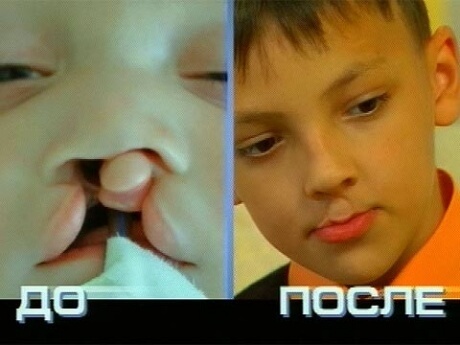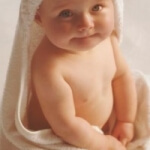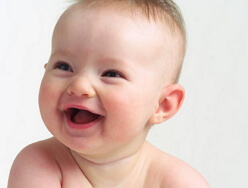The most common childhood diseases in children under 1 year old
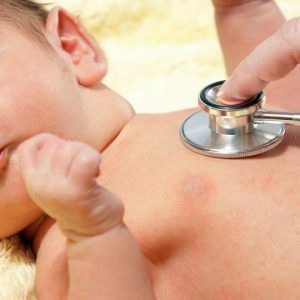
The birth of a child is not only a joy, but also an experience, excitement and anxiety about his health.Unfortunately, in the early childhood( up to 1 year) children can have a variety of diseases, some of them progressing from the first days after the birth of the baby.
Table of contents: Omphalitis and unhealed umbilical cord Umbilical hernia Jaundice of newborns Problems with skin integumentOmphalitis and unhealed navel wound
Umbilical cord is formed in a newborn by the 3rd to 5th day of its life, located on the site of a dropped umbilical remainder.Pediatricians warn parents that, until the baby's umbilical wound is fully healed, one should only bathe in boiled water with the addition of potassium permanganate( "manganese") to a pale pink shade.This period corresponds to two weeks. After the child has been cleared, a number of manipulations are necessary, but only with cleanly washed hands:
- moisten the cotton swab in a 3% solution of hydrogen peroxide and remove the residue of the secreted secret directly from the wound;
- take a new wand and remove the remnants of hydrogen peroxide;
- grease the umbilical wound with a solution of brilliant green( 2% zelenka).
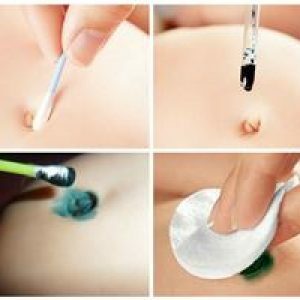 Important! The loafers, sliders and diapers need to be ironed on both sides after each wash, the underwear changes to the baby several times a day, you need to make sure that the umbilical wound is not covered by the diaper.
Important! The loafers, sliders and diapers need to be ironed on both sides after each wash, the underwear changes to the baby several times a day, you need to make sure that the umbilical wound is not covered by the diaper.
If the umbilical wound begins to become wet, blood and / or pus discharge appear, the skin around the navel acquires a red tinge, then the health visitor or pediatrician should be notified about this.Most likely, it will be about omphalitis - an inflammation of the umbilical wound of bacterial origin caused by staphylococci or streptococci. With this pathological condition, the general health of the baby will change:
- the baby is restless and constantly crying, or, conversely, becomes very sluggish;
- the kid badly sucks a breast;
- there is a weight loss;
- in some cases increases body temperature.
Treatment of omphalitis is a four-time treatment of the umbilical wound, and in severe cases the pediatrician can prescribe and treat antibacterial drugs.
Please note: if the hygienic care for the umbilical cord of the parents is carried out in strict accordance with the rules, then there will be no omphalitis.This inflammatory process is always the result of insufficient care.
Umbilical hernia
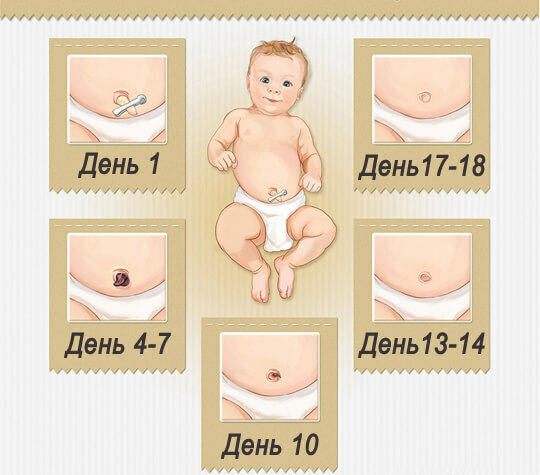
This is the name for the exit of the internal organs through the large umbilical ring - this is the weakest point in the anterior abdominal wall of the newborn.Such pathology is diagnosed at infancy, often, parents can see it: with crying or straining the baby appears hernial protrusion, which is a consequence of increased intra-abdominal pressure.
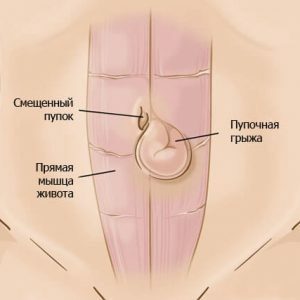 As soon as the umbilical hernia is detected, the child needs to be shown to the surgeon - the doctor will correct the hernia of the child and apply a special plaster for 10 days .Such treatment sessions can be applied several times in a row, additionally prescribed therapeutic physical training and massage - procedures that only a specialist should perform.
As soon as the umbilical hernia is detected, the child needs to be shown to the surgeon - the doctor will correct the hernia of the child and apply a special plaster for 10 days .Such treatment sessions can be applied several times in a row, additionally prescribed therapeutic physical training and massage - procedures that only a specialist should perform.
If the baby already knows how to hold the head, then it should be spread on the tummy on a hard surface.Such simple "measures" will help not only to direct the organs in place, but also to normalize the stool, to exclude constipation.
In some cases, the hernia in the child does not disappear and to one-year age and in this case the child will be shown the operation .As a rule, surgical interventions for umbilical hernia are performed only from the age of three, but if the hernia falls out too often, then experts recommend that such cardinal treatment be performed earlier.Jaundice of the newborn
The most common icteric coloring of the skin and mucous membranes in the newborn is a physiological manifestation of the adaptation period after birth.Jaundice appears, as a rule, on the 2-3 day after the birth of the baby and this is due to the lack of sufficient enzymes that neutralize toxic bilirubin.Normally neutralized in the hepatic cells, bilirubin is released after a series of transformations from the body with feces or urine.But in a newborn, the liver does not have time to disinfect all bilirubin, its blood level rises rapidly, which leads to a rapid coloration of the skin and mucous membranes in yellow.
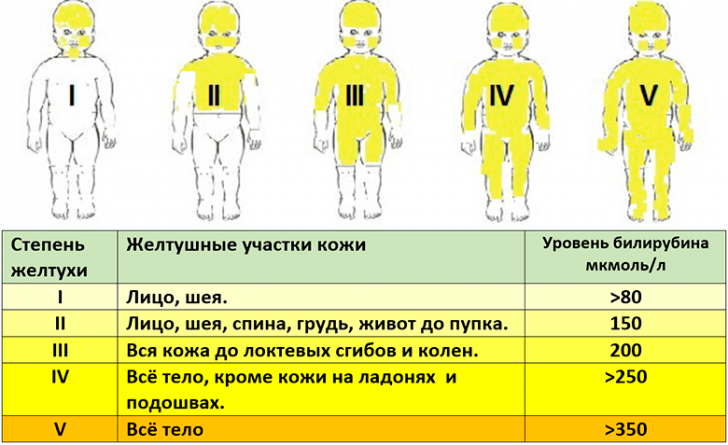
Similar jaundice of newborns is a physiological process and does not represent any danger to the life of the child. Jaundice develops in 60% of full-term infants and in 90% of premature babies, spontaneously disappears for a maximum of three weeks .
There are cases when physiological jaundice persists longer than three consecutive weeks, which may be due to the transition of physiological jaundice to jaundice of natural feeding. The fact is that breast milk contains a substance that can inhibit or block the formation of hepatic enzymes - this phenomenon has not been fully studied yet, but it has a place to be.
As a rule, and jaundice of natural feeding does not pose a threat to the health and life of the child, but nevertheless, a full examination of the baby follows. In some cases, the cause of such prolonged jaundice may be:
- mass destruction of erythrocytes - hemolytic jaundice;
- impaired hepatic cell function - hepatic jaundice;
- obstruction of the biliary tract - mechanical jaundice.
These pathologies require constant monitoring of the level of bilirubin in the blood.If this indicator does not exceed the limits of the norm, or the increase is insignificant, then the doctors simply observe the newborn.But in case of a sharp increase in the level of bilirubin in the blood, surgical treatment may be required, since this development of pathology is fraught with serious consequences for the brain.
Skin problems
The baby's skin is very delicate and easily skinned, the blood vessels are superficially located, and even with a slight overheating of the baby from the skin, moisture begins to evaporate.These three factors cause problems with skin integument in children under the age of one year.
Fins
This is the name for inflammation of individual skin areas when there was a prolonged exposure to moisture or friction.Most diaper rash occurs in the armpit, cervical, inguinal, intercostal folds or behind the auricles.
Depending on how the diaper ripples, doctors distinguish three degrees of its severity:
- first degree - redness is insignificant, the integrity of the skin is not broken;
- second degree - redness becomes bright, microcracks and erosions appear;
- the third degree - reddening intense, on a skin there are cracks, erosions and pustules.
Fatigue causes a feeling of pain, burning and itching, which leads to anxiety and vagaries of the baby.The causes of the problems under consideration with skin integument can be the increased skin moisture, and the excess weight of the baby. It is possible to distinguish and provoking factors:
- defective drying of the skin after bathing or undermining the baby;
- infringement of rules of care of the child, irritation of a skin under influence of urine and a feces;
- rubbing skin with synthetic clothing;
- child overheating;
- is an allergic reaction of the baby's skin to the material from which the used diapers are made.
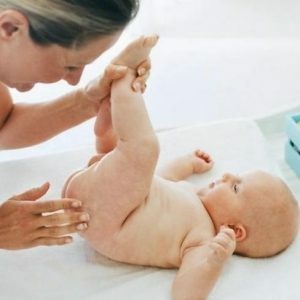 Do not ignore intertrigutions in any case!Such a pathological lesion of the skin can quickly spread, an infection joins it.Therefore, parents should control the temperature in the room where the baby is - it should not be above 21 degrees, you should regularly hold the baby air baths.
Do not ignore intertrigutions in any case!Such a pathological lesion of the skin can quickly spread, an infection joins it.Therefore, parents should control the temperature in the room where the baby is - it should not be above 21 degrees, you should regularly hold the baby air baths.
At the first degree of diaper rash, no specific treatment is required, it is enough only to carefully observe the rules of skin care, change diapers in time( at least every 3 hours), carry out air baths and wrinkles with a protective cream.If you can not get rid of diarrhea within 24 hours, you need to consult a pediatrician - a specialist who evaluates the skin condition of an infant may prescribe the use of medications( for example, Drapolen or Bepanten ointments).
The second degree of intertrigo involves the use of special "chatters" - a tool that is made in pharmacies.A pediatrician can prescribe a treatment with tannin or methyluracil ointment on the affected area.In the case of pustules, the skin is treated with "green" or blue methylene.
To bathe a baby with the second degree of diaper rash, it is necessary to use a weakly pink solution of "manganese", and if the baby does not have allergies to medicinal herbs, then it can be done with the oak bark broth( the time is a maximum of 7 minutes).
The third degree of diaper rash is hard to treat, so parents should do their best to prevent this development of pathology.If the skin is already wet, then use any ointment oils for medicinal purposes can not be - will form a film that prevents the healing of wounds.The optimal solution to the problem of diaper rash of the third degree will be to seek qualified medical care.
Sweating
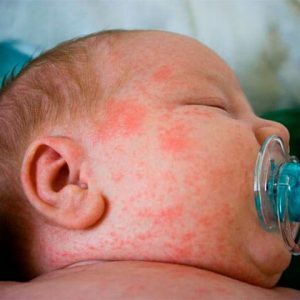 This is a disease that is characterized by the appearance on the skin of the baby with a small-colored rash of pink color.Usually, such a lesion occurs in those places where the sweat is most prominent in the baby - natural skin folds and folds, buttocks.Sweating, usually, no unpleasant symptoms are accompanied, and the behavior of the newborn remains unchanged.
This is a disease that is characterized by the appearance on the skin of the baby with a small-colored rash of pink color.Usually, such a lesion occurs in those places where the sweat is most prominent in the baby - natural skin folds and folds, buttocks.Sweating, usually, no unpleasant symptoms are accompanied, and the behavior of the newborn remains unchanged.
Most often, the perspiration disappears without any specific treatment - it is enough to follow the rules of care for baby skin, you can lubricate the affected area with Bepanten cream.
To prevent the occurrence of sweating, the following preventive measures are used:
- all baby underwear must be made of natural fabrics;
- for walking it is necessary to dress the kid strictly according to the weather;
- in a room where most of the time the baby spends, the air temperature should be constant within 19-21 degrees;
- for bathing use decoctions of chamomile or oak bark, but only if the baby does not have allergies;
- baby skin cream is used only on a water basis.
Diaper dermatitis
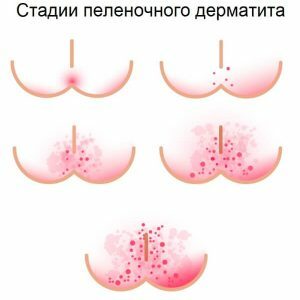 The disease is manifested by reddening of the skin, swelling, scaling and the appearance of small bubbles.Diaper dermatitis is accompanied by itching and burning, which makes the child restless and capricious, disturbs his sleep.
The disease is manifested by reddening of the skin, swelling, scaling and the appearance of small bubbles.Diaper dermatitis is accompanied by itching and burning, which makes the child restless and capricious, disturbs his sleep.
If the treatment of the disease in question is not carried out, then on the affected areas of the skin there are cracks, pustules and erosion.Further, the surface layer of the skin is rejected, ulcers may form, often an infection, fungal or bacterial, is attached to diaper dermatitis.
Treatment is performed only as directed by a pediatrician or dermatologist.
Pimple of newborns
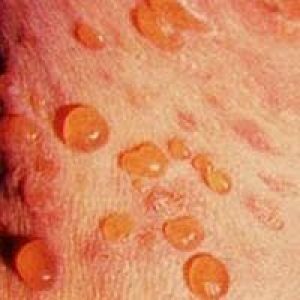
This is a purulent infectious skin disease that is caused by Staphylococcus aureus.There is a disease in the first weeks of life, the infection of the baby can occur from carers with pustular infection on the hands.
Sign of the disease will appear on the skin of the baby large bubbles with a turbid liquid of yellowish color.They often open themselves, leaving an eroded surface after that.The liquid that flows out of the bursting bubbles, contributes to the infection of neighboring skin areas.
The complications of pemphigus of newborns can be abscesses and septic conditions.Treatment of the disease in question is carried out only by the pediatrician.Be sure to use antibiotics in therapy, and, regardless of the age of the child.
Hormonal crisis
The hormonal crisis develops in healthy, full-term infants and this condition is associated with the ingestion of mother hormones into the body of the child through the placenta or with natural feeding. Symptoms of such a condition will be:
-
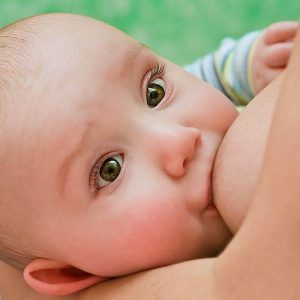 white discharge according to the type of colostrum from the mammary glands;
white discharge according to the type of colostrum from the mammary glands; - breast engorgement;
- secretion from the genital tract in girls bloody or gray-white liquid;
- pigmentation in boys near the scrotum and nipples;
- appearance of small white with a yellowish hue of points on the bridge of the nose, forehead, chin and wings of the nose.
Similar changes appear on the 3-4 day life of the baby and for 30 days gradually reduce the intensity, no treatment is required. The only thing you need to remember for your parents: it's strictly forbidden to squeeze out the thoracic glands, to massage them, as this can lead to the progression of mastitis, which requires surgical treatment.
Thrush
Symptom of thrush - on the tongue and mucous membranes of the baby's cheeks appear white spots that resemble pieces of curdled milk.Such raids are not washed away in the intervals between feedings, but they are removed with a spatula, if the disease is mild.With moderate weight of the thrush, spots appear on the palate, lips and remove them completely will not work.
Severe degree of thrush is characterized by the rapid spread of dense raids on the gums, the back of the pharynx, on the soft palate.Places of infection with fungal infection are painful, the baby is crying heavily, his sleep is broken, he either sucks badly, or completely refuses it.
Factors that can trigger the emergence of thrush include:
-
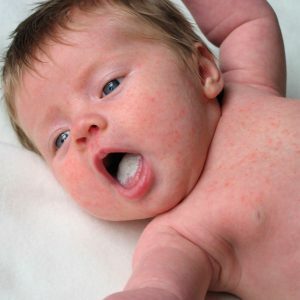 prematurity;
prematurity; - hypotrophy;
- dysbiosis;
- artificial feeding;
- anemia;
- acute and chronic infections;Regurgitation and vomiting
- ;
- rickets;
- disorders of metabolic and endocrine processes.
For initial manifestations of the disease, the oral cavity should be treated with a sterile cotton swab that is wetted in a weak solution of "potassium permanganate" or 2% soda solution.After rubbing, the mucous membranes are lubricated every three hours with a solution of blue methylene for 5 days.
Treatment of thrush in newborns is carried out using drugs that contain Nystatin or Levorin. During the entire treatment period, mom should clean her nipples with baking soda before each feeding, boil toys / nipples / bottles.Severe form of thrush is treated only in the hospital.
Rickets
Despite the modern possibilities of medicine, rickets is still one of the most common diseases of infants.This disease develops due to a lack of vitamin D in the body, which is "responsible" for the phosphorus-calcium metabolism.The child receives this vitamin along with food, and it is synthesized in the skin under the influence of sunlight.Therefore, according to statistics, the frequency of diagnosing rickets in children born in the winter is much more frequent than those who were born in the warmer days.
In rickets, there is not only a lack of vitamin D, phosphorus and calcium, but also a lack of vitamins B, A and C, iron, zinc, copper, magnesium .Due to the lack of all these microelements, children with rickets become excessively cryptic, capricious, they are disturbed by sleep, often suffer from a cold.
The first symptoms of the disease in question may appear already at the age of one month of infancy, and if the treatment is not carried out, the condition of the child will worsen. Symptoms of rickets in infants include:
-
 increased sweating on the palms and head;
increased sweating on the palms and head; - at the nape of the neckline;
- the odor of urine becomes pronounced;
- babe often cries for indigestion;
- the abdomen becomes flat, the joints are loose, which is caused by a decrease in muscle tone;
- softening of the bones, which leads to a flattening of the occiput, formation of frontal tubercles, deformation of the thorax;
- curvature of the lower limbs;
- teeth erupt much later than the prescribed time;
- anemia;
- frequently recurring intestinal and respiratory infections;
- enlargement of the liver and spleen;
- thickening of the metacarpal bones of the fingers.
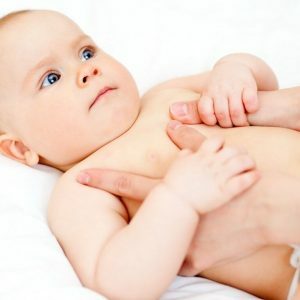 If the treatment of rickets is absent or wrong, the pathology progresses, which is manifested by the narrowing of the pelvis, curvature of the spine, flatfoot and the formation of a hump.
If the treatment of rickets is absent or wrong, the pathology progresses, which is manifested by the narrowing of the pelvis, curvature of the spine, flatfoot and the formation of a hump.
The development of rickets is very easy to prevent - it is enough for children to give vitamin D, and the treatment of the disease, started on time and carried out correctly, gives positive results to .At present, advanced forms of rickets are diagnosed only in children who live in dysfunctional families.
Treatment of rickets is complex and involves the use of various procedures:
- long walks with an infant in the open air;
- correction of the child's diet, which will ensure the growing body with all the necessary vitamins and trace elements;
- therapeutic exercises, massage and swimming classes;
- drug therapy - probiotics, vitamin D, vitamin-mineral complexes.
Digestive problems
Intestinal colic
Severe pain in the intestines of the baby accompanied by bloating is a common problem for babies.The child at the same time actively knits, cramps them, loudly cries.The cause of the appearance of intestinal colic may be maternal nutrition( if the baby is on natural feeding) or ingestion of air during feeding.
To prevent the occurrence of colic and the accumulation of gases in the intestine, it is quite realistic: to do this:
-
 adjust the diet of the mother and eliminate those products that even theoretically can provoke increased gas production;
adjust the diet of the mother and eliminate those products that even theoretically can provoke increased gas production; - immediately after feeding the baby should be held vertically, so that it spewed air;
- periodically give infants as a drink of dill water, a decoction of fennel or Espumizan;
- as often as possible lay out the baby on the stomach;
- if the child begins to worry, then you need to put a warm diaper on his stomach, you can massage his stomach with gentle movements clockwise.
By the age of 3-4 months, intestinal colic in a child undergoes the sex of the reason for the maturation of the digestive tract.
Constipation in infants
 Many parents believe that if a child does not have a chair throughout the day, then this is constipation.But this is not entirely true!The fact is that mother's milk, for example, can be fully absorbed by the body, so it is necessary to judge whether the baby has constipation because of its state of health and the consistency of feces.
Many parents believe that if a child does not have a chair throughout the day, then this is constipation.But this is not entirely true!The fact is that mother's milk, for example, can be fully absorbed by the body, so it is necessary to judge whether the baby has constipation because of its state of health and the consistency of feces.
About constipation can be said in the event that the baby behaves restlessly, cries, constantly tuzhitsya, but the intestine does not emptied. When constipated, the child's stool has a dark color and a dense consistency, can even be hard, like peas or cork.
The reason for constipation in infancy is most often a failure to follow a diet with a nursing mother or an improper diet of a baby who is breastfeeding.To contribute to the development of constipation in infancy can be the mother's enthusiasm for protein products, coffee, flour products. But not everything is so "rosy" - in some cases, constipation in infants is associated with the development of pathologies:
- Hirschsprung disease - infringement of intestinal innervation;
- dolichosigma - lengthening of the large intestine of an innate character;
- lactase deficiency.
Parents should not try to cope with constipation in their own child, it would be wise to seek help from a pediatrician - the specialist will not only diagnose, find out the cause of such disruption of the intestine, but also give recommendations on how to solve the problem.
If the parents are sure that there is no pathology in the child, then with the constipation will help to cope with one of the following means:
- glycerin suppositories;
- irritation of the rectum with the tip of the gas pipe;
- preparations of lactulose, which must be prescribed by a doctor.
Please note: is an ancient way to get rid of constipation, implying the introduction of a piece of soap into the anus, in no case can not be used!Alkaline, which is a part of this remedy, can cause a burn of the intestinal mucosa.
Diarrhea in infants
 A child under one year of age can empty the intestines after each feeding.But if in this mode the general condition of the baby remains within the norm, he is calm and eats well, then parents should not worry.The main importance in such frequent emptying of the intestine is the color, consistency of the stool and the presence of impurities of blood or mucus in it.It is worth remembering that the liquid stool is dangerous because of the organism of the baby, too much fluid will be eliminated.
A child under one year of age can empty the intestines after each feeding.But if in this mode the general condition of the baby remains within the norm, he is calm and eats well, then parents should not worry.The main importance in such frequent emptying of the intestine is the color, consistency of the stool and the presence of impurities of blood or mucus in it.It is worth remembering that the liquid stool is dangerous because of the organism of the baby, too much fluid will be eliminated.
The causes of a loose stool may be:
- improper feeding of the nursing mother or the baby;
- Acute intestinal pathology - for example, appendicitis or intestinal obstruction;
- intolerance of some products;
- dysbacteriosis;
- acute intestinal infection.
If a baby has diarrhea, should be immediately consulted for qualified medical care.It is especially important to follow this rule if diarrhea has started for no apparent reason, and bowel evacuation occurs too often.Prior to the arrival of a specialist, the baby needs to ensure a sufficient supply of fluid into the body.
Regurgitation of
This phenomenon occurs in almost every child, which can be physiological or pathological. Physiological regurgitation is associated with underdevelopment of the digestive system:
- esophagus narrowed or relatively short;
- sphincter of the entrance to the stomach is underdeveloped;
- the gastric mucosa is highly sensitive and reacts to any irritant, including, and to mother's milk;
- the shape of the esophagus is funnel-shaped.
Especially often physiological regurgitation is noted in premature infants, it disappears only by the age of nine months.If the baby's condition is not disturbed, there is nothing to worry about .Physiological regurgitation may also occur with improper feeding of the baby or violation of the care rules:
-
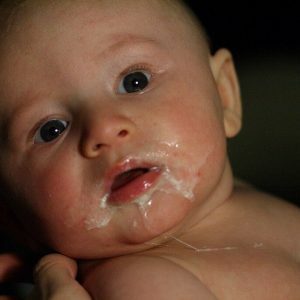 constant overeating - more common in children who are on artificial feeding;
constant overeating - more common in children who are on artificial feeding; - swallowing air along with milk when the baby is applied incorrectly to the breast;
- increased gassing;
- re-laying on the tummy immediately after feeding;
- tight diaper after feeding.
The following measures will help to get rid of physiological regurgitation:
- during feeding, keep the infant in a semi-vertical position;
- with artificial feeding use a special pacifier that prevents swallowing of air;
- does not overfeed your baby;
- after feeding for a while hold the child in a vertical position until the moment of regurgitation of air.
Organic causes of the condition under consideration:
- Pyloric stenosis - constriction of the entrance of the stomach, which refers to developmental abnormalities;
- lesion of the nervous system in prenatal development;
- phenylketonuria, galactosemia - a violation of the assimilation of food of a hereditary nature;
- viral and bacterial infections;
- pathological lesions of the kidneys and pancreas.
Conjunctivitis
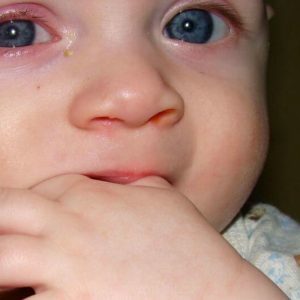 This is the name for inflammation of the mucous membrane of the anterior surface of the eye and the inner surface of the eyelid. The cause of the development of this disease are bacteria, viruses and fungi and only in very rare cases, conjunctivitis can be an allergic reaction.
This is the name for inflammation of the mucous membrane of the anterior surface of the eye and the inner surface of the eyelid. The cause of the development of this disease are bacteria, viruses and fungi and only in very rare cases, conjunctivitis can be an allergic reaction.
The disease under consideration is reddening of the mucous eye, itching and discharge of pus from the conjunctival sac.After sleep, the cilia of the baby stick together with pus, which prevents opening the eyes.
Treatment of conjunctivitis in children should be carried out only under the supervision of an ophthalmologist, because it is the specialist who can select effective medications.Parents can only ease the baby's health by washing the eyes with chamomile tea or marigold, but this can only be done after consulting a doctor.
ARVI
 Acute respiratory viral infections are a group of diseases caused by various viruses transmitted by airborne droplets.In general, ARVI is considered the most common disease in childhood, are not exceptions and babies.
Acute respiratory viral infections are a group of diseases caused by various viruses transmitted by airborne droplets.In general, ARVI is considered the most common disease in childhood, are not exceptions and babies.
Clinical manifestations of acute respiratory viral infections are cough, runny nose, shortness of breath, frequent sneezing, increase in body temperature of the baby .The child at the same time can become sluggish and sleep a lot, his appetite disappears.
As soon as the first signs of acute respiratory viral infection appear in the infant, it is necessary to call the pediatrician at home - this will allow to start effective treatment of .The child needs to provide a plentiful drink: at the age of up to six months the baby can be given warm boiled water, and older children - a decoction of raisins, cranberry juice, infusion of chamomile or broth of wild rose.If the child has consumed too much liquid or was forcibly fed, this will trigger a fit of vomiting - you should not worry, but you need to adjust the dosage of the foods and fluids you use.
Note: against a background of high body temperature, babies may start cramping - the baby's body is stretched, limbs tremble or twitch, eyes roll up.In this case, parents should immediately strip the baby, give him an antipyretic and call an ambulance.
Hip dysplasia
This diagnosis is made in the case of underdevelopment of the hip joint even in utero development - the femoral head has increased mobility within the joint, the development of connective tissue is disrupted.Most often hip dysplasia occurs in children with breech presentation.It is very important to diagnose pathology early, therefore, as part of a baby's examination, an orthopedic examination is performed 1-3-6-12 months.If the doctor suspects a deviation from the norm, he will prescribe a x-ray examination or ultrasound to the baby, but not before the child reaches the age of six months.
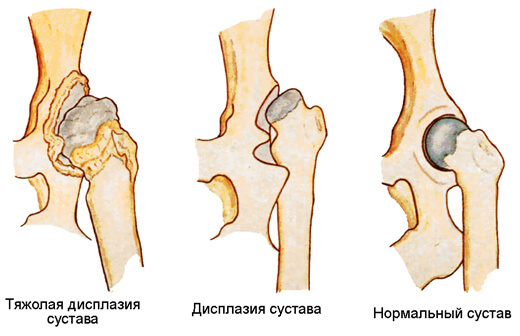
Symptoms of hip dysplasia include:
- additional folds on one leg;
- asymmetry of folds on hips and buttocks;
- crying or restlessness of the baby when trying to breed its legs;
- clicks when the legs are bent, bent at the knee joints;
- unequal length of legs.
Depending on how hard the disease undergoes, babies can be prescribed:
- exercise therapy;
- of the Pavlik stirrup;
- massage;
- bus of the Freik.
With the help of special orthopedic devices, the child's legs are constantly in a diluted and bent position - this creates optimal conditions for the correct formation of joints.First, the baby should wear such struts 24 hours a day, then the wearing mode becomes softer.Parents should in no case before the due date remove the devices, since this can lead to zero all the results previously achieved.
Krivosheya
Krivosheya - this is the wrong position of the head, in which it is deflected in one direction.The appearance of vice depends on the development of the baby.
Signs of the examined pathology in the first year of a baby's life:
- in the first two months of life - when the child is laid out on the abdomen, an increased tone of the muscles of the back and neck is seen, on the legs there will be an asymmetry of folds;
- in 3-5 months - there is a slowdown in the growth of the child and a decrease in the response to any sonic stimulus;
- in 6-7 months - strabismus is noted, the child stands on toes, teeth come through late;
- in 7-12 months - the asymmetry of the folds on the hips and buttocks is clearly traced, the asymmetry of the shoulders, the curvature of the spine, the baby starts to walk late and lags far behind in physical development from his peers.
The reasons for the development of torticollis are the following:
-
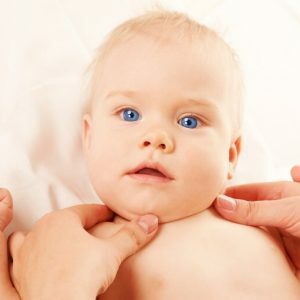 damage to the neck muscles, which may be due to improper position of the fetus;
damage to the neck muscles, which may be due to improper position of the fetus; - developmental defects of the vertebrae;
- umbilical cord cervicalis;
- injury to muscles or cervical vertebrae in childbirth;
- is an intrauterine muscle inflammation that ends with shortening or scarring;
- abnormal development of the muscular and nervous systems.
If the torticollis is determined, then an orthopedic and neurologist consultation is required - specialists will be able to determine the true cause of the disease and prescribe the correct treatment.Parents should not postpone the visit to the doctors and the beginning of treatment, since neglected torticollis can lead to deformation of the vertebrae and face.
For the treatment of the considered disease, the following can be used:
- physiotherapy - electrophoresis, magnetotherapy;
- application of a special collar;
- exercise therapy and massage;
- treatment by position;
- specially selected exercises in the pool or in the bathroom.
There is also a surgical treatment for torticollis, but if the therapy was started in a timely manner, then it will not be needed.
Diseases of the first year of life of a child can pose a certain danger to the health and life of a person in the future.Therefore, parents should be extremely attentive to their newborn children - this will help to notice violations of health on time, seek qualified help and avoid serious consequences.
Tsygankova Yana Aleksandrovna, medical reviewer, therapeutist of the highest qualification category

